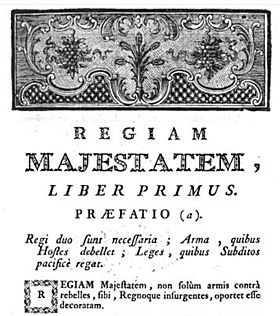Regiam Majestatem facts for kids
The Regiam Majestatem is one of the oldest surviving books about the laws of Scotland. Its name comes from the first two words of the document. This important book is divided into four main parts. These parts cover different areas of law, such as rules for everyday disagreements, how court decisions are made, agreements between people, and rules about crimes.
This book was written in the early 1300s. It was mostly based on an English law book from 1188 called the Treatise on the laws and customs of the Kingdom of England. The Regiam Majestatem also included ideas from church law (called canon law) and older Scottish Celtic laws.
Much of Scotland's legal history was lost in the 1200s and 1300s. This happened because Edward I of England took many documents. Also, two big English invasions led by Edward I and Edward III caused a lot of damage. When the Regiam Majestatem was found in the early 1400s, it became a very important source of law. It helped rebuild Scotland's legal system and was used for a long time.
Later, in 1609, a man named Sir John Skene published his own version of the document. He had put it together and edited it himself. Even though Skene's version was not exactly the same as the original, it became the standard one. When people talked about the Regiam Majestatem after that, they were usually talking about Skene's 1609 book.
What is in the Document?
When the Regiam Majestatem was found in the 1400s, it was quickly accepted as a key legal text. The Scottish Parliament even set up groups to study it and fix any problems. This shows how important it was. The book has remained a vital part of Scotland's unique legal system even today.
In 1607, the Scottish Parliament decided to pay for John Skene's version of the Regiam Majestatem to be published. This version came out in 1609. Some people have said that Skene's book had mistakes and was not perfectly accurate. However, it was still a very valuable work. It helped people understand ancient Scottish law much better. Skene's version became the official legal standard from that time onwards.
The Four Books
The Regiam Majestatem gets its name from the first two words of its first chapter. This first chapter is like an introduction or preface. It begins with a Latin sentence that means: "The Royal Majesty must be adorned not only with arms against rebels rising up against him and the Kingdom."
The book is divided into four main parts, or "books," each covering different legal topics:
| Book | Chapter | What it's about |
|---|---|---|
| I | I – XXXI | This book deals with everyday legal disagreements and court powers. It talks about things like how to settle arguments over property. It also mentions that 12 men had to agree on a decision in some disputes. Rules for buying and selling land and goods are also included, along with different types of agreements. |
| II | I – LXXIV | This part is about court decisions and how they are carried out. It discusses the role of people who help settle disputes (called arbiters). It also covers topics like freedom from slavery and a widow's share of her husband's property (called the terce). Rules about who inherits property are also found here. |
| III | I – XXXVI | This book focuses on agreements and debts. It covers topics like money owed, buying and selling things, and using items as a promise for a loan (pledging). |
| IV | I – XL | This section is all about crimes. It includes serious offenses like killing the king (called lese majeste). It also covers acts of rebellion and other major crimes. |
Important Legal Terms
The Regiam Majestatem includes many old Scottish legal terms. Here are a few examples:
- Amerciamentum: This was a fine given if someone did not show up when they were supposed to.
- Arreragium: This term meant money that was owed, like unpaid rent or duties.
- Attachiamentum: This was a way to make sure a person would appear in court. It could also mean taking control of someone's goods.
- Breve de nova dissasina: This was a legal paper used for cases about theft or taking property by force. The Breve de recto was an old type of legal paper used for property disputes.
- Clarificatio: This meant the clear decision given by a jury.
- Deodand: In English law, this meant giving up an object that caused someone's death. In Scotland, a jury would decide the value of the object. This value would then be paid as a fine if the owner was found responsible.
- Quia Emptores: This is a Latin phrase that refers to an English law from 1290. The Regiam Majestatem includes an exact copy of this law.
See also


